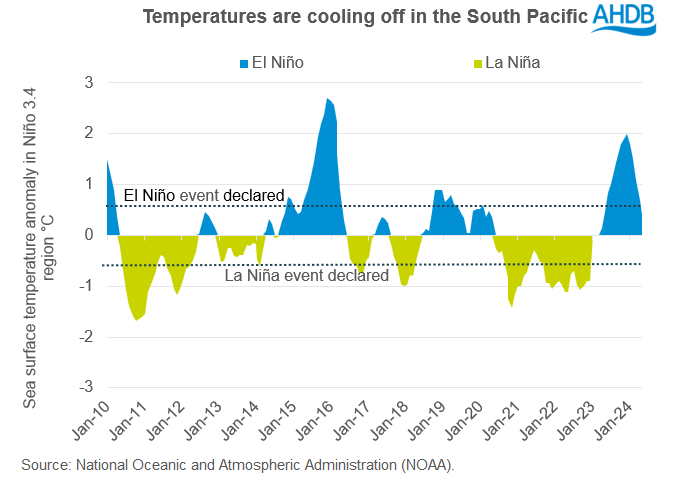La Niña weather event could return during summer 2024: Grain market daily
Thursday, 11 July 2024
Market commentary
- UK feed wheat futures (Nov-24) closed yesterday at £196.25/t, down £0.70/t on Wednesday’s close. New crop futures (May-25) closed at £204.80/t, down £1.85/t over the same period.
- The domestic market followed both the Chicago and Paris futures down yesterday. The market faced pressure due to anticipated strong US 2024/25 end of season stocks, the progressing US harvest, and improving crop prospects in Russia.
- Further to that, news that India might sell wheat from its reserves, helped to temper discussions about the country being a net importer this year.
- Paris rapeseed futures (Nov-24) closed at €483.75/t, down €6.50/t on Wednesday’s close. Rapeseed markets mirrored the weaker soyabean markets, influenced by harvest pressure in the US and South America, leading to rising export competition. Additionally, the market is awaiting Conab’s monthly Brazilian crop forecasts and the USDA’s updated estimates of South American production, which are scheduled for release on Thursday and Friday this week.
Sign up to receive the Weekly Market Report and Grain Market Daily from AHDB.
La Niña weather event could return during summer 2024
Most major weather organizations predict a high chance of La Niña forming this year, though the timing and severity of the weather event vary. American weather forecaster NOAA predicted a 65% likelihood of La Niña weather event developing during July to September and an 85% chance during November to January.
A La Niña event happens when the South Pacific temperature drops more than 0.5°C below normal. The cooler the temperature, the more severe the event.

The La Niña weather situation often leads to major changes in global weather patterns, affecting grain and oilseed production and so prices. This phenomenon can result in cooler, wetter conditions in some areas, while causing drier, warmer conditions in others.
Below, we explore how a La Niña event can affect some of the key grain and oilseed producing regions and what potential impact it might have on prices.
South American crops could be hit by drought
In South America, rainfall tends to be quite scarce with very high temperatures and several heat waves, which stress crops and reduce yields. With the region’s importance in global supply of soyabeans and maize, reduced crop yields due to a La Niña event in late 2024 and/or early 2025 could create a bullish market sentiment. However, the actual impact on crops will depend on the severity of the La Niña event, which is still uncertain at this time.
Australia (in parts) could see flooding
Historically, a La Niña weather event causes higher rainfall in Australia, which can support yields but can also lead to flooding in parts of the country. The timing is important as crops reach key growth stages in September and October. However, If La Niña intensifies towards end of the year, as predicted, it could adversely affect rapeseed crops during harvest. Australia’s rapeseed area is lower this year, which could indicate tighter global supply since the country is a top exporter of rapeseed/canola. Also, with demand expected to exceed supply for the upcoming season, prices could be supported.
Impact on crops in the US
La Niña is linked to mixed weather conditions across the US. In southern US, La Niña events cause drier conditions, which may lead to a challenging start to the 2025 winter wheat crop in the autumn. However, La Niña brings cooler and wetter conditions to Midwestern US, which could benefit 2024 maize and soyabean crop yields this summer. With an uncertain wheat outlook and a higher dependence on US maize yields for total global grain supply, a La Niña event could boost US maize crop, potentially driving prices down.
Summary
In summary, La Niña’s impact on grain and oilseed prices depends on the specific weather patterns and their effects on crop yields in key producing regions. Currently, it’s uncertain how significantly the predicted La Niña weather this year will affect global crop production. If the impact is negative for production, we might see an increase in prices, including support for domestic ex-farm prices.
Sign up to receive the latest information from AHDB.
While AHDB seeks to ensure that the information contained on this webpage is accurate at the time of publication, no warranty is given in respect of the information and data provided. You are responsible for how you use the information. To the maximum extent permitted by law, AHDB accepts no liability for loss, damage or injury howsoever caused or suffered (including that caused by negligence) directly or indirectly in relation to the information or data provided in this publication.
All intellectual property rights in the information and data on this webpage belong to or are licensed by AHDB. You are authorised to use such information for your internal business purposes only and you must not provide this information to any other third parties, including further publication of the information, or for commercial gain in any way whatsoever without the prior written permission of AHDB for each third party disclosure, publication or commercial arrangement. For more information, please see our Terms of Use and Privacy Notice or contact the Director of Corporate Affairs at info@ahdb.org.uk © Agriculture and Horticulture Development Board. All rights reserved.

